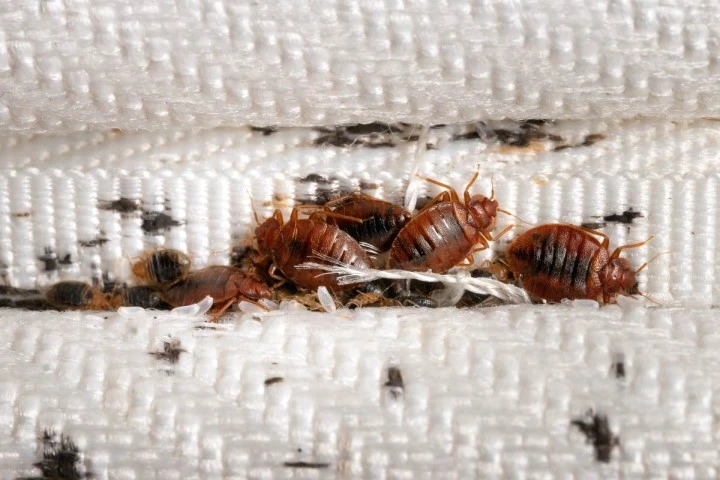Everything about Bed Bugs

| Everything About BEDBUGS | |
|---|---|
| Feature | Description |
| Types | Mainly Cimex lectularius (common bedbug) and Cimex hemipterus. |
| Size | Adult bedbugs are about the size of an apple seed, roughly 5-7mm in length. |
| Common Habitats | Primarily found in bedrooms, hiding in mattresses, box springs, bed frames, and nearby furnishings. |
| Diet | Exclusively blood. They can survive several months without feeding but typically feed every 5-10 days. |
| Behavior | Nocturnal and elusive, they come out at night to feed and return to their hiding places afterwards. They do not transmit diseases, but their bites can cause itching and allergic reactions. |
Dissecting Bed Bugs Anatomy
Bedbugs (Cimex lectularius and other species) are small, wingless insects known for feeding on the blood of humans and other animals. Here’s a breakdown of their anatomy:
Head
Prothorax (Front Part of the Thorax)
Abdomen
Head
- Antennae: Bedbugs have a pair of segmented antennae. These antennae are sensitive and play a crucial role in navigating their environment and sensing hosts.
- Compound Eyes: These eyes are somewhat reduced compared to other insects. They are adapted to detect changes in light, which helps bedbugs determine when it’s safest to emerge and feed (typically during the night).
- Mouthparts (Rostrum): Bedbugs have a set of piercing-sucking mouthparts. Their elongated proboscis is designed for piercing the skin and drawing blood. The rostrum contains two tubes: one to inject saliva that contains anticoagulants and anesthetics, and another to withdraw blood.
Prothorax (Front Part of the Thorax)
- Legs: Bedbugs have three pairs of legs, which are relatively short and designed for crawling. The feet have small claws at the tips that help the bugs grip surfaces.
- Spiracles: These are small openings used for breathing. Like other insects, bedbugs respire using a tracheal system that transports oxygen from the spiracles to the tissues.
Abdomen
- Hemelytra: Although bedbugs are wingless, they possess vestigial wing structures known as hemelytra. These are remnants of what would be wings in other insects, appearing as small pad-like structures on their back.
- Scent Glands: Bedbugs can produce a distinctive and often unpleasant odor, which is released from their scent glands. This odor is often described as sweet or musty.
- Reproductive Organs: Male bedbugs possess a unique reproductive structure used to pierce the female’s abdomen during a process called “traumatic insemination.” Females have a specialized organ called the spermalege to receive sperm during this process.
- Abdominal Segments: The abdomen is flexible and can expand significantly after feeding. This allows the bedbug to ingest a large quantity of blood relative to its size.
- Ovipositor (in females): This is a tubular structure through which females lay eggs.
How to Get Rid of Bed Bugs?
Getting rid of bedbugs requires a strategic approach including deep cleaning and Bed Bug Treatment. For minor infestations, DIY treatments might be effective. However, with larger infestations or if DIY treatments fail, it’s essential to employ professional Bed Bug Treatment & Removal services.
These experts use specialized methods to ensure thorough eradication. The decision between DIY and professional help should factor in the severity of the infestation, budget, and the urgency for a comprehensive solution.
What are the most common types of Bed Bugs in Canada
In Canada, while there are various species of bedbugs, only a few are primarily responsible for infestations in homes or accommodations. Here are the most common types of bedbugs you might encounter in Canada:
Common Bedbug (Cimex lectularius)
Suffering from Bed Bug Infestation?
What are the characteristics of Common Bed Bugs?
| Characteristics of Common Bedbug | |
|---|---|
| Feature | Description |
| Size | Adults are about 4-5 mm in length. |
| Color | Reddish-brown, becoming more reddish after feeding. |
| Shape | Oval and flat. |
| Lifecycle | Under optimal conditions, bedbugs can develop from an egg to an adult in as little as a month. |
| Feeding Habits | Primarily nocturnal, they feed on the blood of humans, but will also feed on birds and mammals if necessary. |
Call PPS for a Free Bed Bugs Inspection
Top Tips To Prevent Bed Bugs Infestations: Essential Guide
- Regular Inspections: Regularly inspect your sleeping areas, especially mattresses, bed frames, and headboards. Look for live bugs, their excrement, or small blood stains. Using a flashlight can help in darker corners.
- Limit Second-hand Furniture: Be very cautious when bringing second-hand furniture into your home. Inspect it thoroughly for signs of bed bugs. This is especially crucial for mattresses, sofas, and other soft furnishings.
- Travel Smart: When staying in hotels or other accommodations, check the bed area for signs of bed bugs. Keep your luggage off the floor and bed, opting for luggage racks when available. When returning home, inspect your belongings and consider washing all your clothes—even those not worn—on a hot cycle.
- Use Protective Covers: Utilize bed bug-proof covers on your mattresses and box springs. These covers are designed to prevent bed bugs from entering or exiting.
- Be Cautious with Shared Laundry: If you use shared laundry facilities, transport your clothes in plastic bags. Once cleaned, ensure the clothes are placed back into a fresh, unused bag. Using a dryer at high temperatures can also kill bed bugs, so consider drying clothes on the highest setting for at least 30 minutes.
Frequently Asked Questions about Bed Bugs
Bedbugs are small parasitic insects that feed on the blood of humans and animals. They are oval-shaped, reddish-brown in color, and typically measure around 5 to 7 millimeters in length.
Bedbugs are skilled at hiding in cracks, crevices, and small spaces near where people sleep or rest. They can be found in mattress seams, headboards, furniture, and even electrical outlets
Preventing and controlling bedbug infestations involves several steps. These include regular cleaning, vacuuming, and reducing clutter to eliminate hiding places. When traveling, inspect hotel rooms for signs of infestation. If you suspect an infestation, contact a professional pest control service for thorough treatment, which may include heat treatments or insecticide application.
